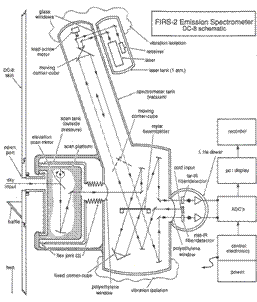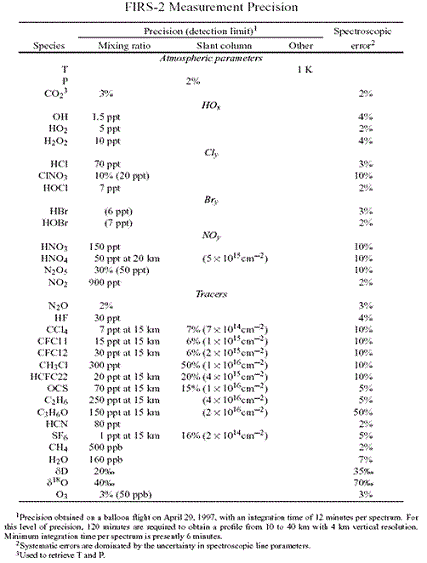Infrared-Like Instruments
Figure: Schematic Diagram of the FIRS
-2 System.
An excellent example of an 'infrared-like' instrument which operates in the Submillimeter Terahertz is the FIRS-2 Fourier Transform Spectrometer operated by the Smithsonian Astrophysical Observatory Far-Infrared Spectroscopy Group [1]. It is balloon or aircraft borne and covers the far- (80 - 340 cm-1) and mid-infrared (330 - 1220 cm-1) with an apodized resolution of 0.008 cm-1 (240 MHz). The longer wavelength of these two regions corresponds to 2.67 - 11.33 THz and overlaps nicely with the region typically thought of as the high frequency end of the THz. In this region, thermal sources produce significant power even at atmospheric temperatures and (as does MLS) FIRS-2 observes the stratosphere in thermal mission. This enables it to make abundance measurements during both day and night in any azimuth heading. Additionally, although obtained in a very different way, like MLS, FIRS-2 is a multiplex instrument that simultaneously observes many species. The heritage of FIRS-2 is that of an optical FTIR and its layout is shown in Figure: Schematic Diagram of the FIRS-2 System . The configuration shown here is that designed for use on the NASA DC-8 platform. FTIR instruments are multiplex in that all of the energy over a very wide band is simultaneously present on the detectors. The spectra is then recovered via a Fourier Transform of the signal which is recorded as a function of the optical path difference as one of the reflective corner cubes is translated. More specifically, for FIRS-2 the light enters the system at the left where vertical resolution in the atmosphere is obtained with an elevation scan mirror.
It is a dual input dual output system with one image being the sky image and the other a cold source in the detector dewar. The two beams are combined on the left half of the Ge coated Mylar beam splitter. The reflected beam goes to the moving corner cube and the transmitted beam to the fixed corner cube. The beams are then recombined on the right of the beam splitter and focused onto the two detectors. Both are liquid helium photo conductors, with one being for the region ~80 - 320 cm-1 and the other for the region ~320 - 1560 cm-1 limit is set by the cutoff of the photo conductors. The separation into two bands increases the sensitivity of the long wave length portion by isolating it from the strong mid-infrared flux.
Figure: Spectra from FIRS-2. Spectra from
FIRS-2 in the region 80-1400 cm-1 (A) with a
series of graphical expansions (B-D) to show
the resolution and sensitivity of the FTIR tech-
nique. The bottom scan shows less than 1%
of the recovered spectrum.
|
Figure: Spectra from FIRS-2. Spectra from |

Figure: Measurement Precision. Measurement precision obtained |
References
- Smithsonian stratospheric far-infrared spectrometer and data reduction system J. Geophys. Res.: Atmos. 100, 3091-3106 (1995). Google Scholar